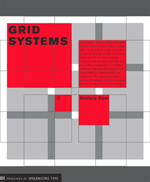 Grid Systems uses modules, transparent overlays, and a wide range of examples to evidence typographic structure through the grid. It shares some traits of another title written by Kimberly Elam, Geometry of Design. While Geometry of Design had mathematics and the golden section as its driving force, Grid Systems utilizes form, function, and hierarchy to demonstrate grid usage. The grid—and especially the golden section—contains a degree of mystery for students who are eager to learn design fundamentals. Elam combats this in Grid Systems by examining and using the grid within the context of other design basics: proportion, grouping, positive/negative space, edges, and thirds. Well-crafted thumbnails illustrate how to put these principles into practice. In the opening chapters, you investigate composition with the above elements and a basic three by three grid set in a square. Composing in a square challenges any designer because of the bullseye convenience. You don’t want to create a target for the eye, you want the eye to move generously across the entire field.
Grid Systems uses modules, transparent overlays, and a wide range of examples to evidence typographic structure through the grid. It shares some traits of another title written by Kimberly Elam, Geometry of Design. While Geometry of Design had mathematics and the golden section as its driving force, Grid Systems utilizes form, function, and hierarchy to demonstrate grid usage. The grid—and especially the golden section—contains a degree of mystery for students who are eager to learn design fundamentals. Elam combats this in Grid Systems by examining and using the grid within the context of other design basics: proportion, grouping, positive/negative space, edges, and thirds. Well-crafted thumbnails illustrate how to put these principles into practice. In the opening chapters, you investigate composition with the above elements and a basic three by three grid set in a square. Composing in a square challenges any designer because of the bullseye convenience. You don’t want to create a target for the eye, you want the eye to move generously across the entire field.
These exercises are interwoven with design samples from Bayer, Kunz, and Nike. A short and detailed background accompanies each and some have ruled overlays to analyze the composition. They encourage readers to look closely at how these designs were assembled—in effect reverse engineering the designs. But observing “the masters” here doesn’t give students the right to mimic their creations. Instead, Elam identifies that design fundamentals and especially the grid are as relevant now as they were during the Bauhaus.
The grid can appear complex, cumbersome, and rigid at times for young designers and students. Grid Systems challenges these notions with Elam’s down to earth approach. If this title proves as useful as other Design Briefs books, we may see it reprinted in the near future with more examples from students. And judging by the book’s introduction, that’s Kimberly’s hope too.
Grid Systems: Principles of Organizing Type by Kimberly Elam
112 pages, Paperback
0.50 x 8.5 x 7.0 inches
Publisher: Princeton Architectural Press
ISBN: 1568984650






But observing “the masters” here doesn’t give students the right to mimic their creations.
Real understanding tends to promote original contribution. It is superficial familiarity that encourages copies.
On Jan.11.2005 at 11:19 AM